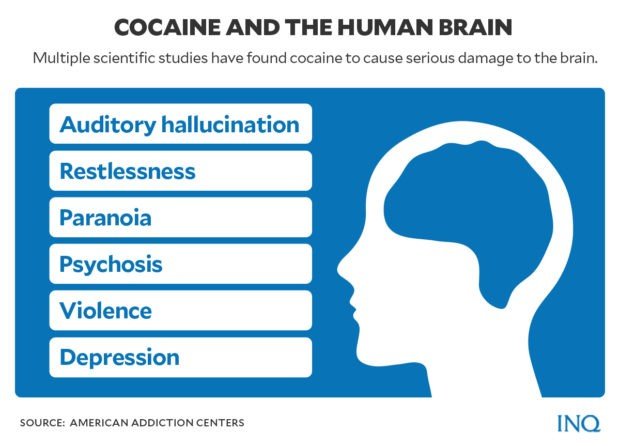Cocaine is a very addictive illegal stimulant that comes from the leaves of the coca plant, also called Erythroxylum coca, a shrub native to South America.
This illegal drug—which can be snorted, smoked, or dissolved and injected into a vein—speeds up messages traveling between the brain and body.

According to the Alcohol and Drug Foundation (ADF), an organization based in Australia, the leaf extract from the coca bush is often processed to produce three different forms of cocaine:
- Cocaine hydrochloride: characterized as a fine white powder with a bitter, numbing taste. “Cocaine hydrochloride is often mixed, or ‘cut’, with other substances such as lidocaine, talcum powder, or sugar to dilute it before being sold,” the ADF said.
- Freebase: a purer form of cocaine hydrochloride.
- Crack: in crystal form, which the ADF said could range from white or cream to transparent with a pink or yellow hue. Unlike the other two forms, this kind may contain impurities.
The United State’s National Institute of Drug Abuse (NIDA) explained that while cocaine can be used by health care providers for valid medical purposes—including local anesthesia for some surgeries—recreational use of cocaine is illegal.
“As a street drug, cocaine looks like a fine, white, crystal powder. Street dealers often mix it with things like cornstarch, talcum powder, or flour to increase profits.” the NIDA said.
“They may also mix it with other drugs such as the stimulant amphetamine, or synthetic opioids, including fentanyl. Adding synthetic opioids to cocaine is especially risky when people using cocaine don’t realize it contains this dangerous additive,” it added.
“Cocaine causes an intense flood of chemicals in the brain’s ‘pleasure’ or ‘reward’ pathway—essentially short-circuiting what would normally only be stimulated, or roused, by pleasurable life events,” the Cleveland Clinic said.

When this brain circuit is overloaded due to cocaine use, it causes changes in the brain which makes a person think that nothing would be pleasurable without the drug—a sign of cocaine addiction.
The illegal use of cocaine could lead to a series of more serious and life-threatening side effects, according to medical experts.
Dangerous impact of cocaine
The NIDA listed some serious immediate physical and mental effects of cocaine use including irritability, anxiety, increased temperature, increased heart rate, high blood pressure, and possible death.

Meanwhile, short-term effects, according to the ADF, include making a person:
- feel increased confidence and happiness
- feel energetic and alert
- feel physically strong
- feel mentally sharp
- more talkative
- anxious
- paranoid
- irritable and agitated
Other short-term effects are headaches, dizziness, dry mouth, dilated pupils, high blood pressure, high body temperature, rapid heartbeat and breathing, increased sex drive, insomnia, and indifference to pain.
Depending on how the cocaine is used, there are different harmful long-term effects to a person, said the Cleveland Clinic.
Snorting cocaine: nosebleeds, runny nose, loss of smell, hole in the nasal septum, hole in the roof of the mouth, and difficulty or issues in swallowing.
Injecting cocaine: increased risk of IV-related viruses from shared needles like hepatitis C and HIV or AIDS; vein collapse and scarring; infections in the heart valve, skin, and soft tissue.
Smoking cocaine: cough, irregular breathing, asthma, higher risk of lung infections including pneumonia and bronchitis.
Cocaine absorption through gums in the mouth: mouth sores or ulcers on the gums including the underlying bone, receding gums, chronic gingivitis, dry mouth and tooth decay.

Cocaine addiction can also lead to severe weight loss and malnourishment, movement disorders, intestinal death and rupture caused by constricted blood vessels or lack of oxygen to the intestinal tract.
Cocaine and the human brain
The American Addiction Centers (AAC) said cocaine can cause long-term damage to mental health, which could be observed in the form of mood or emotional disturbances.
“Because the drug directly interferes with dopamine being reabsorbed by neurons, one of the symptoms of a cocaine comedown is serious depression,” the US-based health care company said.
These serious long-term changes to mood, mental health, and cognitive function brought by cocaine abuse include:
- auditory hallucinations
- restlessness
- paranoia or extreme and unreasonable distrust of others
- psychosis
- unpredictable, violent, or aggressive behavior
- depression
Long-term cocaine addiction can also lead to damages to the physical structure of the brain.
Aside from damaged lining of the veins and arteries, blood clots in the brain, seizures, a study conducted by scientists from the University of Cambridge showed that the brains of people who abused cocaine but had no previous history of drug abuse rapidly deteriorate.
“The group found that the average brain normally loses 1.69 milliliters of gray matter per year,” AAC said. “However, people who had abused cocaine in the past, or who were currently cocaine-dependent, doubled the rate of gray matter loss, for an average of 3.08 milliliters per year,” AAC added.
Another study conducted by Johns Hopkins University found that cocaine may push brain cells to “cannibalize themselves.”
“The study describes cocaine triggering autophagy in neurons in mice, or the process of the cells eating themselves from the inside out,” AAC detailed.
“The cells throw out useful resources during metabolism, leading to a stress reaction of cannibalizing other internal cell structures,” it added.
Top 10 drug rehab centres in South Africa
South Africa Free Drug Rehab – Galino House

